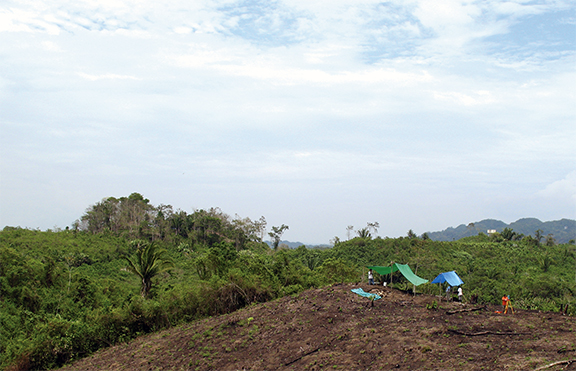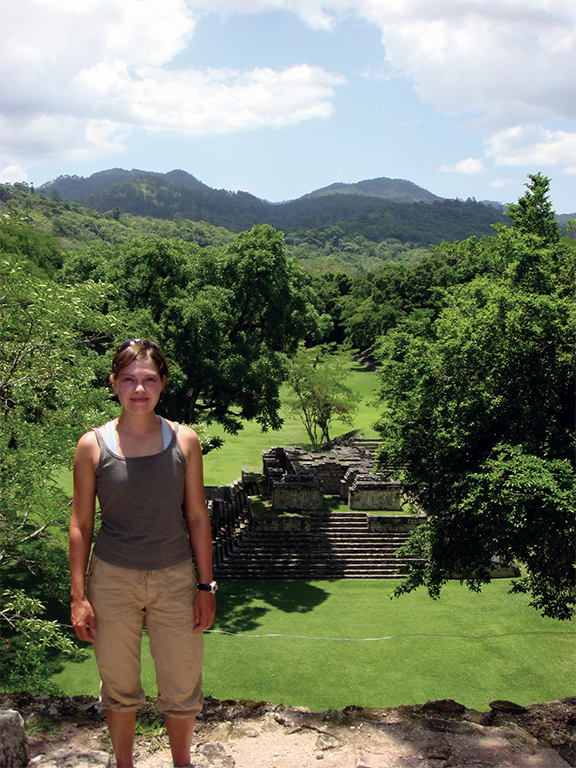
excavated a settlement of ancient Maya commoners who
once lived in southern Belize.
Lured by the mystique of the ancient Maya elite, archaeologists too often overlook the commoners. Recent excavations are bringing them out of the shadows.
The burial in structure three of Wichita State graduate student Amber Schrag’s Maya Settlement Group 21 is perplexing. “It’s mysterious,” she concedes, as she takes time from thesis preparation to share her archaeological research on the ancient Maya site of Uxbenká in southern Belize.
Schrag’s research focuses on Maya commoners, whose ways of living have long been overshadowed by the monumental palaces, temples and plazas, the complex burials, huge ballcourts and exotic household and ceremonial goods of the Maya elite.
The burial Schrag and her team uncovered during last summer’s dig was sheered in two, with only the top fourth of the skeleton and the crypt’s limestone capstones remaining. “There’s no explanation,” she confides.
Schrag’s excavation of Settlement Group 21 is part of a wider investigation of a site called Uxbenká (pronounced “ush-ben-kah”), which generally dates from the Maya civilization’s Classic Period (AD 250-900). The Uxbenká Archaeological Project began with the combined efforts of archaeologists from Wichita State, Cleveland State and West Valley College.
Keith Prufer, a former WSU assistant professor of anthropology now with the University of New Mexico-Albuquerque, is project director and one of UAPs principal investigators. “Uxbenká,” he explains, “is the earliest site in the southern half of Belize and was occupied continuously for almost 1,000 years. It went from a small farming hamlet to the capital of a medium-sized polity that controlled access to important agricultural resources, minerals and trade routes to the sea.”
In professional circles, Uxbenká is perhaps best-known for its Early Classic (AD 200-500) stelae, which are free-standing stone slabs carved with images of rulers and hieroglyphic texts. The monuments have provided archaeologists with clues into the dynastic history of Uxbenká’s elite, suggesting the existence of a political relationship with Tikal, a massive site more than 100 kilometers northwest of Uxbenká and a powerful Maya urban center. But about the nonelite members of the Maya polity, the stelae are silent.
“Keith has a passion for the Maya and for this area of Belize,” says Schrag, who’s originally from South Dakota. Always interested in history, her earliest anthropological explorations were looking around her family’s farm for traces left by pioneer settlers. A graduate of Bethel College in North Newton, Kan., she also worked for several years as a museum interpreter, researching and overseeing a number of exhibition projects. But it was only after enrolling in graduate school at WSU that her attention fell to the Maya. “I was curious about the Maya,” she says. “Keith’s interest was definitely an inspiration to me.”
Prufer, who has conducted archaeological research in southern Belize for well over a decade now, has been concentrating on Uxbenká in recent years. In both 2005 and 2006, he received an Awards for Research/Creative Projects in Summer (ARCS) award from Wichita State and a grant from the Foundation for the Advancement of Mesoamerican Studies Inc. (FAMSI) to investigate the site. The 2005 field season was geared toward mapping Uxbenká’s site core and urban center and gathering data on the carved monuments and sculptures.
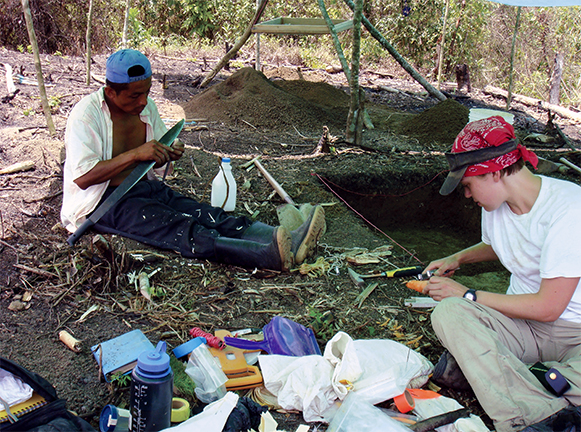
Andre, led a group of investigators that included not
only fellow anthropologists, but also residents of the
village of Santa Cruz, many of whom are descendants
of the ancient Maya. The Maya occupied a region in
Mesoamerica that ranged from Mexico's Yucatan
Peninsula south through Belize, Guatemala,
Honduras and El Salvador.
Since the site is located within the modern village of Santa Cruz, the UAP has taken on an applied social and cultural aspect. Through collaboration with cultural anthropologists from Florida International University and Boston College, project members actively involve Santa Cruz residents, who are the living descendants of the ancient Maya, in the study of their past.
In 2006, Prufer was awarded a National Science Foundation grant, which runs through 2009, to continue the UAP’s work. During the 2006 field season, he and members of his excavation team discovered the remains of a carved wooden canoe-like object in a cliff-top cave more than 200 meters above the valley floor.
Although Kayuko Naj Tunich (Canoe Cave) appeared to have been used as a royal burial crypt, later investigation found no human bone, suggesting the space functioned as an altar, rather than a tomb.
“The canoe dates to about AD 100, making it very old,” Prufer relates. “The cave that it was in is a foundational shrine for the city of Uxbenká.”
In 2007, Holley Moyes, WSU visiting assistant professor of anthropology, led a salvage expedition to the cave. The canoe-like object was removed and readied for transport to the University of Arizona in Tucson for conservation and further study. In her interim report about the field activities, Moyes sums up what is known about the canoe: “Because of the poor state of preservation, it may not be possible to determine exactly what the object was meant to represent, but this year’s salvage operation did determine that it was an element of ritual focus in the cave, and the Late Preclassic radiocarbon date substantiated its antiquity.”
Schrag’s Settlement Group 21 lies on a steep hillside in the shadow of another settlement group higher up. The dark maw of Canoe Cave can be glimpsed across the valley. “The ancient Maya who lived at Uxbenká belonged to different social groups,” Schrag reports. “Excavation data determined SG 21 was a nonelite settlement based on the small scale buildings and the utilitarian production- and consumption-oriented artifacts. The two burials we found, with their minimal and simple grave goods, were also evidence of the nonelite status of SG 21 inhabitants.”
Until recently, Schrag relates, most investigators of the ancient Maya employed “top-down” research, primarily investigating large architectural complexes and monuments at site cores. “These areas, while very important to understanding Maya civilization, are associated with a quantitatively small elite or noble class,” she says. “The majority of the population was nonelite, but not much work has been done in researching the nonelite aspect of the Maya’s complex society. It’s exciting to be able to add to the information about these ancient commoners.”
Prufer concurs. “Yes,” he says, “most work has been focused on large public architecture and little on the humble farmers who formed the backbone of Maya social and economic systems. In many ways, the work Amber has done is not so much about big finds, but more about providing important information on early households and families.”
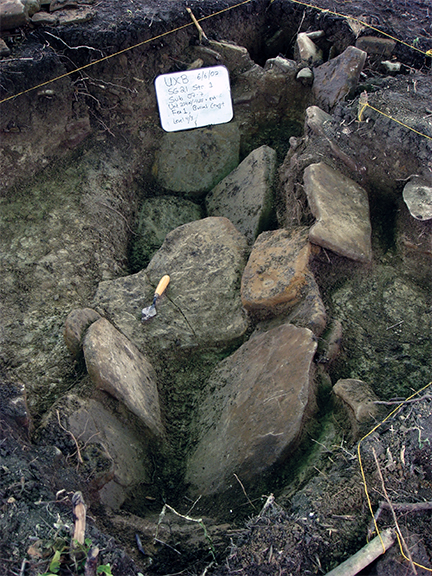
the Maya nonelite Settlement Group 21 at Uxbenká. One
of the burials was dated to AD 179-334, while two
charcoal pieces associated with the burial site were
dated to AD 646-772.
Schrag explains that SG 21 comprises three main structures, all small and simply-constructed platforms made of limestone and sandstone blocks. There is also, she reports, a “muddled” grouping of stones that may be remnants of a fourth structure.
The ruins of these buildings are situated around a central, flat, cleared area. “Ethnographic research and studies of prehistoric murals in Guatemala and Mexico indicate that the platforms might have had wooden superstructures with thatch roofs,” she says.
The artifacts that she and her team recovered — including chipped stone tools and lithic debris, metates, manos, ceramic sherds, an axe fragment and hammer stones — point to everyday activities, domestic dwellings, food preparation areas and a small agricultural plot.
A few exotic items were also found, including a clay figurine and some modified jade fragments. Underneath the houses labeled STR 1 and STR 3, Schrag’s team uncovered two burial crypts. “The individual in the structure-one burial was interned clutching a bowl and with minimal grave goods, including five polychrome pottery sherds, a jute shell and a spindle whorl,” Schrag says, adding that radiocarbon dating by team member Brendon Culleton places the age of the burial at between AD 179 and AD 334.
Later study of the skeleton by Willa Trask ’07 revealed that the disrupted burial in structure three was of a male between the ages of 18 and 35 at the time of death. Two dated charcoal samples from STR 3 and an associated midden (trash heap) put the probable age range of the burial as being from AD 646 to AD 772. The skeleton, Schrag reports, also shows signs of cranial modification, which the ancient Maya were known to practice.
“The burial that was chopped in half is very interesting,” Prufer says. “It shows both that people buried the dead in the houses, and that someone at some point dug into the house and cut through some earlier burial.”
Schrag adds, “The structure-three burial and the muddled layout of the possible fourth structure suggest construction and later remodeling. There is evidence from other sites that the ancient Maya remodeled their settlements.”
After piecing together last summer’s findings, Schrag has built up a mental picture of SG 21 and its inhabitants. In her mind’s eye, she sees several family clusters whose members spend most of their time outdoors. “I imagine,” she says, “that some of them wore modest jewelry — we found some pieces of jade, for instance. Some of them might have had tattoos.”
It’s hot and humid, but they tend their gardens, planting or harvesting such crops as maize, gourds, squash, peppers, perhaps cacao.
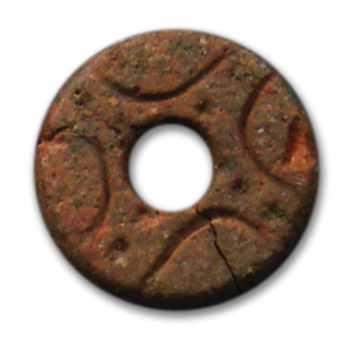
They craft, or trade for, stone tools, some made out of obsidian. They fashion ceramic bowls and jars. Domestic chores are never-ending. They make their own clothes, grind maize on metates, cook, clean, watch over their youngest and their oldest. They celebrate births and, with simple ceremony, bury their dead.
The artifacts and ruins of the dwellings and ancillary buildings at Settlement Group 21 “pale in comparison to the elite and ceremonial structures at Uxbenká, differentiating it from the upper crust of society,” Schrag relates. “While the social stratification is obvious, it appears elites and nonelites were living in the same general areas of the site.
At Uxbenká, Group F was just up a steep hill from SG 21, but Group F had monumental architecture — and all the buildings faced away from SG 21, as if denying visual and physical access from SG 21.”
Schrag’s SG 21 people may have lived, worked and died in the shadow of those living higher up the hill, but more than 1,000 years after the Maya civilization’s crest, the investigative efforts of today’s archaeologists have begun bringing them into the full light of day.

